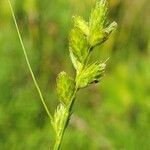Densely tufted, aphyllopodic, 3–12 dm; main lvs 2–3 mm wide, shorter than the stiff stems, their sheaths ventrally green-veined almost to the summit; spikes 3–10, gynaecandrous, sessile, crowded or the lower separate, ovoid, 6–13 mm, densely fld, the lateral with few staminate fls, hence obtuse or rounded at base; pistillate scales ovate, narrower and shorter than to nearly as long as the perigynia, the midrib not reaching the boat-shaped, mostly obtuse tip; perigynia flatly planoconvex, appressed to somewhat spreading, 3–4.5 × 1.6–2.6 mm, many-nerved on both sides, the body obovate, broadest above the summit of the achene and tapering to the broad beak with the wings reaching the tip; achene lenticular, 1.3–1.7 × 0.75–1 mm; style straight. Swamps and bogs, mostly near the coast, from N.S. to Fla. and Tex.; less commonly inland to Ind., Mich., and Sask., and s. to trop. Amer. (C. albolutescens, misapplied)
Loose tufts to ±40 cm high. Stems ±stout, 3-angled, scabrid on angles below inflorescence. Leaves < stems, ± 2 mm wide; sheaths light brown. Inflorescence 1.5-4 cm long, of 3-6 somewhat separated, ovoid, greenish or greenish-brown sessile spikes; one or two lower spikes with a setaceous bract < inflorescence. Spikes androgynous, male flowers at base. Glumes shorter and much narrower than utricles, obtuse or subacute, hyaline with green midrib. Utricles ± 3.5 × 2 mm, flat, widely winged, minutely scabrid on margins of upper half, broadly obovate, widest just above nut, faintly to strongly few-to many-nerved on each face, sessile, rounded at base, ± abruptly contracted to a beak 0.5-1 mm long. Stigmas 2. Nut oblong, yellowish-brown.


